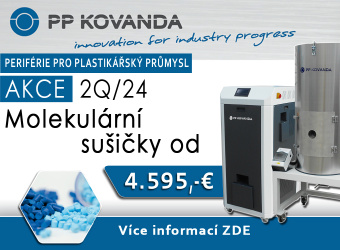Weekly commodity price report
Here are the market prices of various types of commodity plastics PE-LD, PE-HD, PP and PS in Central and Eastern Europe with a delay of 5 weeks. The data was processed by our partner myCEPPI.
Are you interested in current prices for commodity plastics? You can order Weekly polymer price reports from our editors.
Prices for this week 2/2020
The following factors influenced “commodity” polymer prices and price expectations last week:
- BRENT oil price 65.37 USD/barrel, slightly dropping prices
- EUR/USD: 1,1121, a stagnant Euro
- NAPHTHA (European): 533.30 USD/t, slowly further increasing prices
- Contracted monomer prices in January:
- Ethylene (C2) contract price 0 EUR/t (970 EUR/t)
- Propylene (C3) contract price 0 EUR/t (845 EUR/t),
- Styrene monomer (SM) contract price +64 EUR/t (1,017 EUR/t)
- Buyers are just getting information,
- All producers published their prices,
- There are more and more sellers on the market
All producers published their prices this week, Some Western European producers have tried to raise prices without success. Smaller price increases of EUR 10-15 were made selectively only for PP and depending on the type and manufacturer. For the time being, demand is weak, and buyers are either on holiday or just looking for information. Actual purchases can only be expected to start in the week ahead. However, converters also wait. For the time being their stock of raw materials is high.
At the beginning of this year, no new import shipments from outside of Europe came from Russia or North America arrived, and there is temporary calmness. However, more and more new merchants enter the market, therefore it is worth considering what 2020 may bring to the polyolefin market.
In many ways, 2020 will be the watershed for the plastics industry in Central Europe. Both the demand and the supply side will undergo significant changes. On the supply side, new capacities are expected to enter both in North America and Russia. 2018 has given us a taste of what oversupply means. North American HDPE imports in 2019 tripled between January and August 2019 compared to the same period in 2018; it increased from 274,300 tons to 732,007 tons. While average prices fell by more than 15%. The drop in spot prices was even greater. Our region was not so much flooded by cheap North American HDPE, but rather as its spill-over effect by cheap Western European HDPE, from Western European producers who have already based their ethylene production on shale gas. In the third quarter of 2019, reliable, well-known polyethylene brand names were already associated with cheap prices. In the second half of 2019, supply pressure from the east came, although this could only be felt in Poland so far, but this year Hungary can expect a wider supply of Russian polyethylene and polypropylene. SIBUR's new entry capacity of 1.5 million tons of polyethylene and half a million ton of polypropylene will impact directly and indirectly the polymer market. And there are also Russian producers who are losing markets in Russia and the CIS countries due to new factories entering. Unipetrol's new 270kt HDPE plant is expected to be commissioned this year and production is set to begin. This in turn means persistent general oversupply and persistently low prices. But not for all products and not for all segments. The experience of 2018 was that HDPE Film and Blowing Materials became relatively cheaper while the prices of Injection materials rose. Their import quantity is lower. Users have also faced the fact that North American materials do not always and do not completely replace the usual types. However, the most important thing we have experienced in 2018 is uncertainty. In a market that has suddenly become very multi-player market, price news has grown exponentially. It was difficult for converters to decide what reality was. Behind the very cheap prices the amount of supply is a question mark. A zealous trader, with countless phone calls, could easily give the impression that there were hundreds of tons of commodities behind him. For converters, the permanent question is: do I buy at a good price? Or is there a price cheaper than this? Everybody has been aiming for the cheapest price, although the cheaper raw material price also means a smaller margin for plastic converters.
The demand side is also changing. Although the economic crisis has not yet arrived. But the European Union's regulation on car CO2 emissions this year could easily push Central European countries deep. All car manufacturers expect a decline in production. We see smaller, larger redundancies. And we see cheap high melt index PP copolymers on the market from reputable producers. And what's worse is through traders, hidden, very cheaply. While the price in direct sale can even by € 100 higher. Demand in the PP market will be significantly influenced by the automotive industry's adaptation to the changes. Unfortunately, Western European manufacturers might ‘drain’ their excess PPC production via traders in Central European markets.
Producers are trying to pass on the € 64 rise in SM to polymers. More successful with GPPS-HIPS and less with ABS and EPS. The low supply of non-European imports, partly at the beginning of the year and partly due to the tense political situation in Iran, helps the market a lot.
Polyolefin grades
LDPE prices were in a range of 860-980 €/t last week in Central-Europe. Basically a roll-over happened. However, in the southern region, the Romanian producer broke local prices. As this is not a large quantity, the bottom of the price range is expected to rise to around 890-900 €/t by the 20th. Demand is still weak, however, we expect a strengthening in the second half of January. As prices are likely to have reached their lowest point, rising demand may already lead to minor price increases.
Typical HDPE prices were in a range of 910 - 1,010 €/t in Central Europe last week. Everyone came out with new prices, typical prices are as follows:
- HDPE BM 920-980 €/t,
- HDPE IM prices 910-1,020 €/t,
- HDPE FILM grades 910-1,010€/t,
The cheapest prices were in the southern region and Poland. While in the central region the typical price range was rather 950- 1,010 €/t. There are few North American and Russian goods on the market. Demand is also weak for the time being.
Typical HDPE (100) prices were in a range of 1,120-1,210 €/t last week. Contrary to expectations, there was no price increase. Moreover, in Romania, small batches are available from Middle Eastern sources at prices below € 1,100 / t.
LLDPE C4 prices were in a range of 890-980 €/t last week, depending on the grade and application area. In the southern region we saw prices below € 900. However, the Polish market is also willing to buy in the range of 910-940 €/t.
mLLDPE (C6) prices were in a range of 1,020-1,160 €/t last week. They did not change. Supply is consistently plentiful, but demand remains weak.
Typical PPH Raffia prices were in a range of 900-1,030 €/t last week. Smaller price increases (10-15 €/t) were realized in the Czech Republic, Poland and Serbia, but in Romania the local producer price was reduced. Demand is low. There is a limited quantity of imports on the market. However, the converters' stocks of raw materials are now full. Most will only buy towards the end of the month.
The price of PPM IM non-special products with medium melt index was in a range of 900-1,030 €/t last week. But demand is still low. Basically, rollover happened at some locations and for some products, with minor price increased. The price of products with high flow index was in a range of € 980 - € 1,080/t. Smaller price increases of 10-15 € occurred but were not typical.
Typical PPC prices ranged from 1,040 to 1,180 €/t in Central Europe. The big Western European manufacturers were keen to raise, but they failed because of the resistance of the buyers. The market continues to be poisoned by cheap items sold to traders in December last year, which are now the bottom of the price range.
PPR prices were in a range of 1,100-1,220 €/t last week. Basically a roll-over happened. The holiday season balanced demand with supply. There were hardly any transactions, and demand was weak.
The typical prices of the last week are presented in the table below (full truck load 20-22.5 t):
| Grade name | Typical polymer price ranges in the second week of January 2020, Central Europe (€/ton) |
| HDPE BM | 910-980 |
| HDPE Film | 910-990 |
| HDPE IM | 910-1020 |
| HDPE Pipe (100) | 1120-1210 |
| LDPE Film | 890-1000 |
| LDPE GP | 890-1000 |
| LLDPE C4 | 900-980 |
| mLLDPE C6 | 1020-1160 |
| PPC | 1040-1180 |
| PPH IM | 900-1020 |
| PPH IM HMFR | 980-1080 |
| PPH Raffia | 900-1030 |
| PPR | 1100-1220 |
| GPPS | 1100-1200 |
| HIPS | 1200-1300 |
| EPS | 1080-1150 |
| ABS | 1400-1600 |
Polystyrene grades
Typical EPS prices were in a range of 1,080-1,130 €/t last week. EPS producers have tried to transfer monomer price increases to the market. As the season hasn't started yet, the raise was only partially successful. Prices were around 1,100 €/t on average. In the southern region and the Czech Republic prices were lower, while in Hungary and Slovakia prices were higher. Demand is low.
Typical GPPS prices were in a range of 1,100-1,200 €/t, while HIPS prices were in a range of 1,210-1,300 €/t. Producers are trying to pass on the price increase to the market. So far, it looks like success. Demand for HIPS seems good, but demand for GPPS is weak. So far, there is little import. In fact, we don't seem to expect Iranian goods.
Typical ABS prices have been in the range of 1,400-1,650 € over the past week. Producers have tried to pass on the monomer price increase, but due to weak demand, they have only made an average of € 50. It is still possible to buy South Korean materials for around $ 1,400 in case of full wagon loads. The big question for 2020 is how will the ABS price situation develop? Can it go back to a price range close to € 2,000 or will prices remain at this level?
| Type | Price |
|---|---|
| HDPE blow molding | 965 € / t |
| HDPE film | 967 € / t |
| HDPE injection molding | 960 € / t |
| HDPE pipe (100) | 1163 € / t |
| LDPE film | 952 € / t |
| LDPE general purpose | 953 € / t |
| PP co-polymer injection molding | 1122 € / t |
| PP homo-polymer fiber | 978 € / t |
| PP homo-polymer injection molding | 993 € / t |
| PPR | 1155 € / t |
| GPPS | 1132 € / t |
| HIPS | 1255 € / t |
| EPS | 1122 € / t |
myCEPPI – a new voice and new approach on the plastics industry consulting and business intelligence market. With our expert advice, you can get a detailed, up-to-date and tailor-made picture of the Central and Eastern European plastics market and its main trends, data, news and key players.
Our services rely on our personal, regular and in-depth relations with players of the CEE plastics industry.
Each month, we conduct hundreds of interviews and telephone calls with industry players – plastics converters, traders, resin manufacturers – and we are also present at the biggest regional plastics trade fairs and conferences.
The information we collect in the process forms the basis of our weekly price report and market analysis; it feeds into our plastics industry company database; and it serves as the starting point for our multi-level consulting services for companies that need help sizing up, entering or navigating a specific market.
Our experts possess decades of plastics industry experience, as well as fluency in several regional languages.
Our partners include
- key players of the CEE plastics industry – the resin
- master-batch and machinery manufacturers
- distributors, and plastics converters that shape market trends across the region.
We would be happy to welcome you as a partner; please do not hesitate to contact us!
(László Büdy, Managing director, head of consulting)
Price history
- 2024:
- 2023:
- 2022:
- 2021:
- 2020:
- 2019:
- 2018:
- 2017:
Latest Classifieds
-
05.03.2024 | ID: 202418726
Top Advert -
18.04.2024 | ID: 202418992
-
18.04.2024 | ID: 202418991
-
18.04.2024 | ID: 202418990
To purchase: PPSU regrind banner
17.04.2024 | ID: 202418988
For Sale: Packaging press PL 12
17.04.2024 | ID: 202418987
To purchase: POM C regrind colour, white, natur
17.04.2024 | ID: 202418986
-
16.04.2024 | ID: 202418984
-
15.04.2024 | ID: 202418980
To purchase: PPSU regrind banner
17.04.2024 | ID: 202418988
To purchase: POM C regrind colour, white, natur
17.04.2024 | ID: 202418986
To purchase: Package quality LDPE film. 500 t/month
15.04.2024 | ID: 202418966
To purchase: Dirty granulates from ground
15.04.2024 | ID: 202418964
To purchase: PC and PMMA waste, regrinds, lumps etc.
11.04.2024 | ID: 202418943
To purchase: PET transparent trays, only Central Europe due to shipping costs
10.04.2024 | ID: 202418939
To purchase: PA6.6 GF25, TECHNYL A218, original
09.04.2024 | ID: 202418928
-
09.04.2024 | ID: 202418927
-
09.04.2024 | ID: 202418924
-
05.03.2024 | ID: 202418726
Top Advert -
18.04.2024 | ID: 202418992
-
18.04.2024 | ID: 202418991
-
18.04.2024 | ID: 202418990
For Sale: Packaging press PL 12
17.04.2024 | ID: 202418987
-
16.04.2024 | ID: 202418984
-
15.04.2024 | ID: 202418980
For Sale: PP vstrekovací - drť biela
15.04.2024 | ID: 202418979
For Sale: Drť EVA Escorene UL00514
15.04.2024 | ID: 202418978
Upcoming Events
22.04.2024 - 26.04.2024 | Hannover
22.04.2024 - 26.04.2024 | Sao Paulo
23.04.2024 - 25.04.2024 | Maastricht
23.04.2024 - 26.04.2024 | Shanghai
23.04.2024 - 26.04.2024 | Wels
23.04.2024 - 25.04.2024 | Varšava
06.05.2024 - 10.05.2024 | Orlando
Saudi Plastics and Petrochem 2024
06.05.2024 - 09.05.2024 | Rijád
06.05.2024 - 09.05.2024 | Stuttgart
15.04.2024
16.04.2024
16.04.2024
17.04.2024
17.04.2024
Training - Injection moulding technology I.
15.04.2024
Festival of personnel and talent development
16.04.2024
17.04.2024
Training - Injection moulding technology II.
17.04.2024
17.04.2024
Job offers
-
11.04.2024
Plastic worker, gluing staff - FORM s.r.o.
10.04.2024
Logistics, warehouse and shipping supervisor - KNP s.r.o.
09.04.2024
Warehouseman - AIS Automotive Interior Systems Slovakia s.r.o.
09.04.2024
Sales representative / sales specialist - Plastcom, spol. s r.o.
04.04.2024
Maintenance and operation of the production line - Plastcom, spol. s r.o.
04.04.2024
Quality control technician - ESOX-PLAST s.r.o.
04.04.2024
Master of professional training - ESOX-PLAST s.r.o.
04.04.2024
Store manager - Ecocycle s.r.o
25.03.2024
Branch Dictionary






